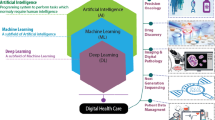Abstract—A mathematical model is proposed to describe and solve problems of medical diagnostics and forecasting based on a risk criterion. Within the framework of the model, problems with ranked diagnoses are considered, whose solution benefits from taking medical preferences into account. A diagnostic algorithm, which is the implementation of this model, is used to solve the problem of predicting the clinical status of prostate cancer. A comparative analysis of the quality of the prediction for four model options was carried out, informative prognostic indicators were revealed, and the results were interpreted. Taking medical preferences into account increases the accuracy of prediction for patients with more frequent and aggressive tumor process due to loss of accuracy for patients with less frequent and aggressive tumor process.








Similar content being viewed by others
REFERENCES
H. Witten and E. Frank, Data Mining: Practical Machine Learning Tools and Techniques, 2nd Ed. (Morgan Kaufmann Publishers, 2005).
P. Flakh, Machine Training (DMK Press, Moscow, 2015).
S. A. Aivazyan, V. M. Bukhshtaber, I. S. Enyukov, and L. D. Meshalkin, “Applied Statistics: Classification and Decrease in Dimension” (Finansy i Statistika, Moscow, 1989) [in Russian].
C. Bishop, Pattern Recognition and Machine Learning, (Springer-Verlag, New York, 2007).
R. A. Fisher, “The Use of Multiple Measurements in Taxonomic Problems,” Ann. Eugenics 7, 179–188 (1936).
T. Hastie, R. Tibshirani, and J. Friedman, The Elements of Statistical Learning, 2nd. Ed. (Springer-Verlag, New York, 2009).
R. Duda, P. Hart, and D. Stork, Pattern Classification, 2nd. Ed. (Wiley Interscience, 2000).
V. Vapnik, Statistical learning theory (Wiley, New York, 1999).
J. Pearl and S. Russell, Bayesian Networks. Handbook of Brain Theory and Neural Networks (MIT Press, Cambridge, MA, 2003), pp. 157–160.
L. Breiman, J. H. Friedman, R. A. Olshen, and C. I. Stone, Classification and Regression Trees (Wadsworth, Belmont, Calif., 1984).
V. G. Gitis, “Metod approksimatsii funktsional’nykh zavisimostei po ball’nym ekspertnym otsenkam,” Probl. Peredachi Inf. 23 (3), 94–100 (1987).
G. Chernov and L. Mozes, Elementary Theory of Statistical Decisions (Sovetskoe Radio, Moscow, 1962).
A. Val’d, “Statistical Decision Functions,” in Position Games, (Nauka, Moscow, 1967), pp. 300–522.
Malignant New Growths in Russia in 2016 (Incidence and Death Rate), Ed. by A. D. Kaprin, V. V. Starinskii, and G. V. Petrova, (MNIOI im. P. A. Gertsena, Moscow, 2018) [in Russian].
L. Klotz, D. Vesprini, P. Sethukavalan, et al. “Long-term follow-up of a large active surveillance cohort of patients with prostate cancer [Journal],” J. Clin. Oncol. 33, 272–277 (2015).
J. J. Tosoian, M. Mamawala, J. I. Epstein, et al., “Intermediate and longer-term outcomes from a prospective active-surveillance program for favorable-risk prostate cancer [Journal],” J. Clin. Oncol. 33 (30), 3379–3385 (2015).
T. F. Hsieh, C. H. Chang, W. C. Chen, et al., “Correlation of gleasonscores between needle-core biopsy and radical prosta-tectomyspecimens in patients with prostate cancer [Journal],” J. Chin. Med. Assoc. 68 (4), 167–171 (2005).
N. N. Volchenko, A. D. Kaprin, M. M. Belyakov, and A. N. Petrov, “Comparative analysis of degree of the differentiation of the prostate cancer on biopsy and operational materials,” Onkologiya. Zh. im. P.A. Gertsena. 1 (5), 8−22 (2016).
E. F. Yurkov, S. A. Pirogov, V. G. Gitis, N. S. Sergeeva, B. Ya. Alekseev, T. E. Skachkova, and A. D. Kaprin, “Forecast of the aggressive status of the prostate cancer for presurgical data,” Inf. Protsessy 16, 301–311 (2016).
A. D. Kaprin, B. Ya. Alekseev, N. S. Sergeeva, T. E. Skachkova, E. F. Yurkov, S. A. Pirogov, V. G. Gitis, N. V. Marshutina, and K. M. Nyushko, “The laboratory index of the clinical separation into stages—the new multiparametrical indicator for the prostate cancer,“ Onkologiya. Zh. im. P. A. Gertsena 5 (1), 23–30 (2016).
N. S. Sergeeva, T. E. Skachkova, B. Ya. Alekseev, E. F. Yurkov, S. A. Pirogov, V. G. Gitis., N. V. Marshutina, and A. D. Kaprin, “The VIZG index—the new multiparametrical indicator for the prostate cancer,” Onkourologiya 12 (4), 89–95 (2016).
P. McCullagh and J. Nelder, A Generalized Linear Models, 2nd Ed. (Chapman & Hall, London, 1989).
J. Long, Regression Models for Categorical and Limited Dependent Variables (Sage, Thousand Oaks, CA, 1997).
A. Agresti, An Introduction to Categorical Data Analysis, 2nd Ed. (Wiley, New York, 2007).
A. Dobson and A. Barnett, An Introduction to Generalized Linear Models, 3nd Ed. (Chapman & Hall, London, 2008).
S. J1. Freedland, W. B. Isaacs, E. A. Platz, et al., “Prostate size and risk of high-grade, advanced prostate cancer and biochemical progression after radical prostatectomy: a search data-base study,” J. Clin. Oncol. 23 (30), 7546–7554 (2005).
Funding
Sections 2 and 7 of the study were performed by S.A. Pirogov and V.G. Gitis in the Institute for Information Transmission Problems (Kharkevich Institute) of the Russian Academy of Sciences with the support of the Russian Science Foundation, project no. 14-50-00150.
Author information
Authors and Affiliations
Corresponding author
Additional information
Translated by O. Zhukova
Rights and permissions
About this article
Cite this article
Yurkov, E.F., Pirogov, S.A., Gitis, V.G. et al. Diagnostic Model that Takes Medical Preferences into Account. Prediction of the Clinical Status of Prostate Cancer. J. Commun. Technol. Electron. 64, 834–845 (2019). https://doi.org/10.1134/S1064226919080266
Received:
Revised:
Accepted:
Published:
Issue Date:
DOI: https://doi.org/10.1134/S1064226919080266




